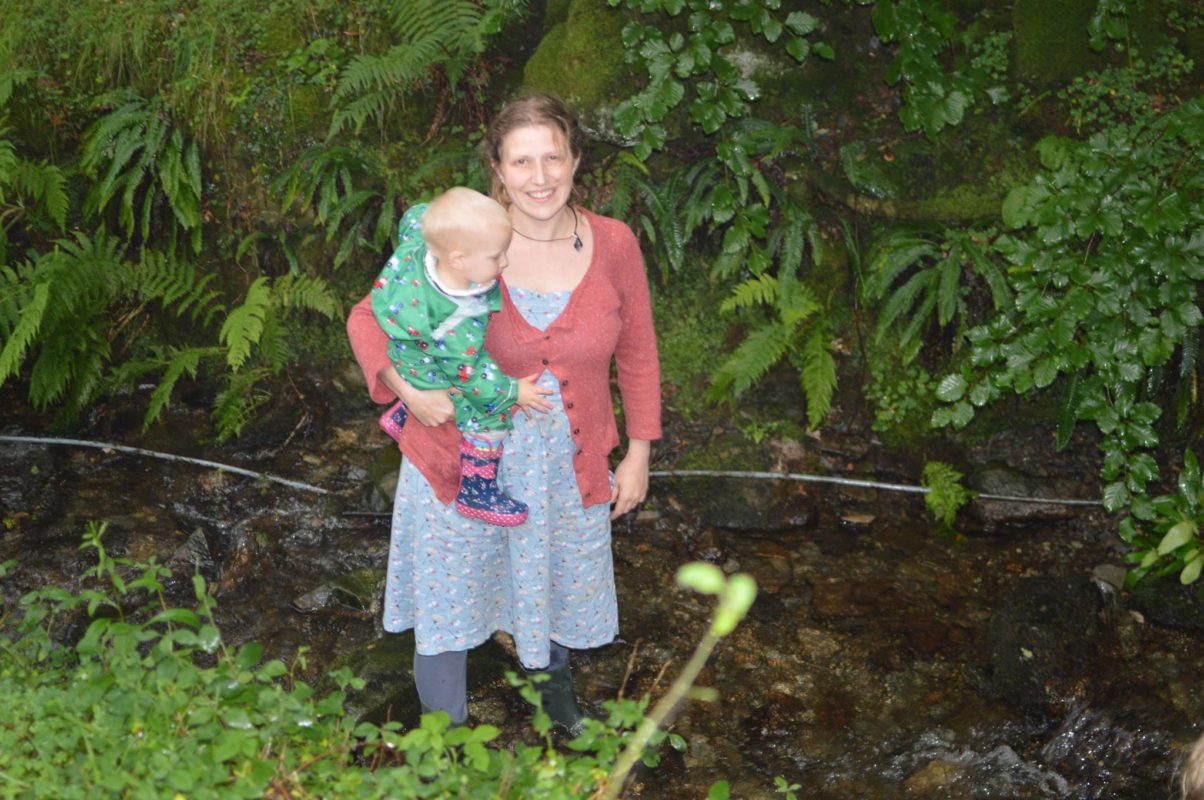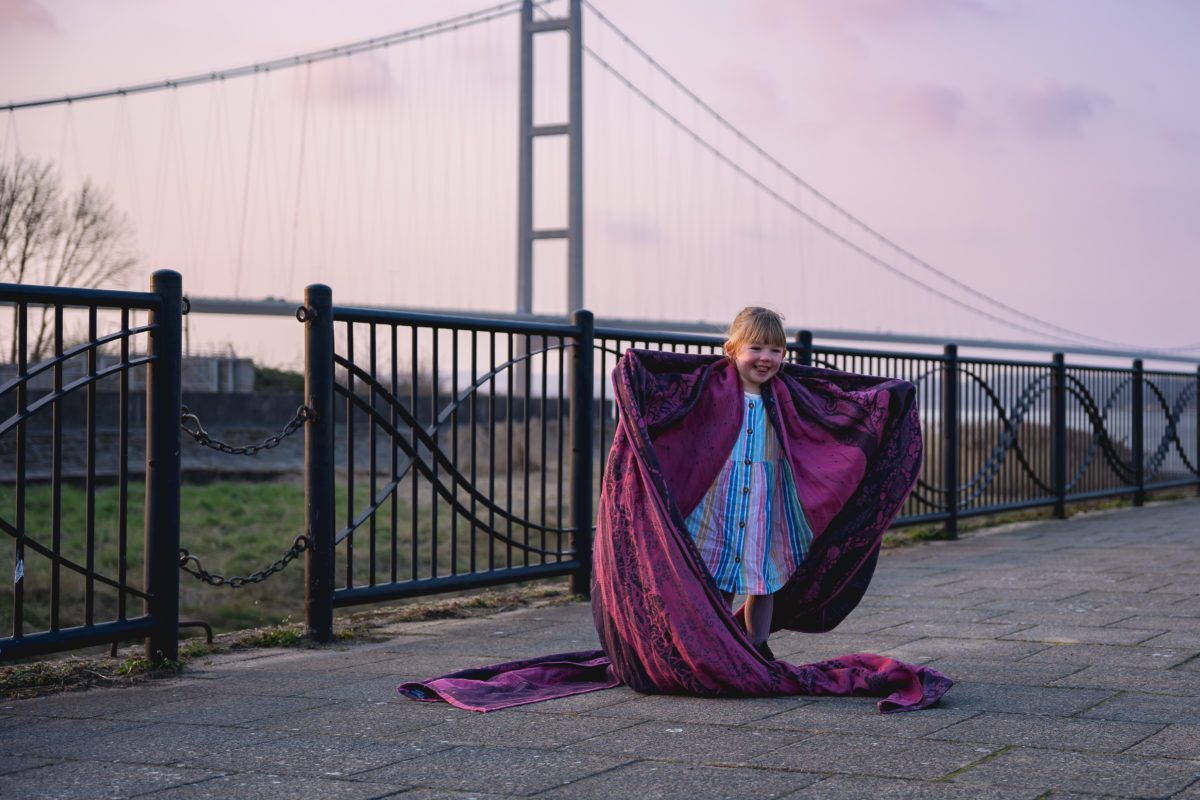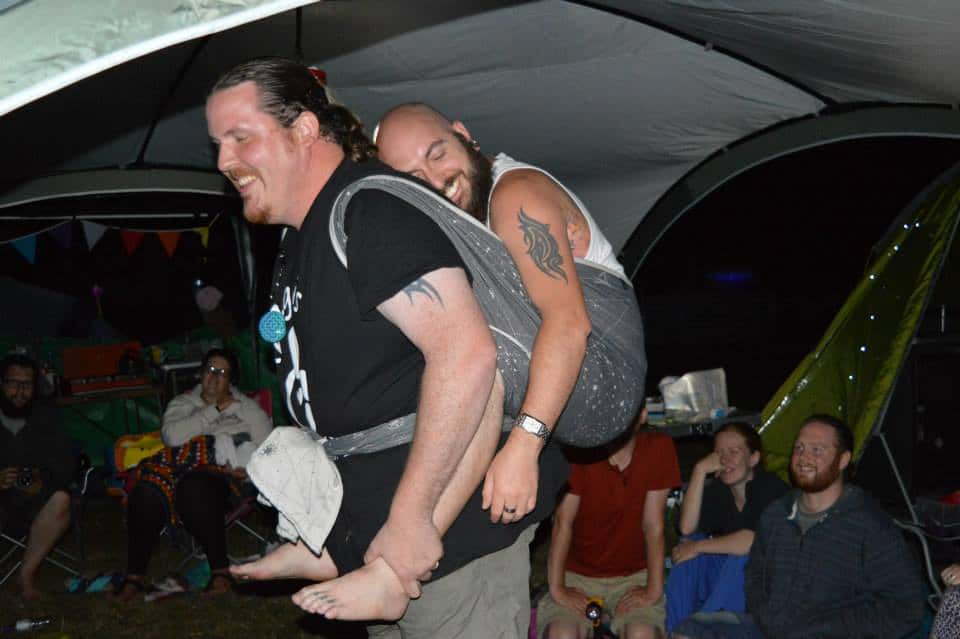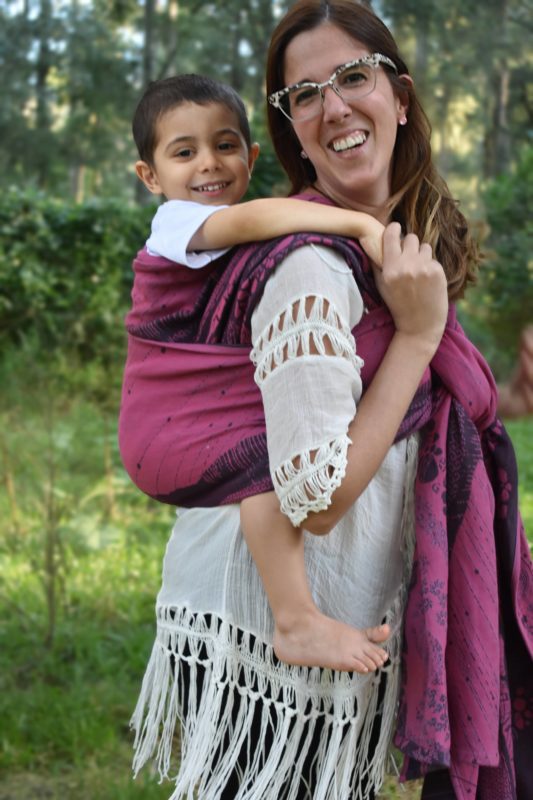Using Woven Wraps
When Should I Stop Babywearing?
There are lots of great reasons for starting to babywear your little one, but how and when should you stop carrying them- is there a point where you shouldn’t be carrying them anymore? We use our decade of experience to talk you through the benefits and practicalities of using woven wraps with older children, and how to know when the time is right to retire the carriers and end your babywearing journey.
When Do I Need To Stop Babywearing?
To answer this we need to look at the natural development pattern for many children generally.
- Newborn babies start off reliant on us to carry them 100% of the time, then gradually become more independently mobile as the months pass.
- Toddlers gradually gain independent movement, but they still need picking up regularly, maybe for comfort or because they’re tired, or even just to see the world from a higher and more interesting perspective!
- Even at 4 or 5 yrs old, children might still need to be popped on your shoulders for a bit of respite on a long walk, or carried in arms when the pace of life around them moves too fast.
So it is normal for older children to still need carrying, whether you use baby carriers or just your arms, and it tends to taper off slowly a children build up their physical and emotional independence. The rate that this occurs is unique to each child and their particular needs.
This means that there is no cut off point where you have to stop babywearing. Like with breastfeeding, bed-sharing or any other thing that involves both caregiver and child, the point to stop is when one or both of you feel ready to stop. If both of you are happy and getting something positive from the experience, then it is fine to carry on for as long as you both like!

Older children will definitely be heavy and more cumbersome in your carrier than when they were small, but if you ditch the carriers too early they’ll just be heavier and more cumbersome in your arms instead!

Tamsin’s experience:
My youngest child Arthur has hypochondroplasia which is a form of short limbed dwarfism. I was regularly wrapping him right up until he started primary school. He loved to be wrapped and his short thigh bones actually made him much easier to wrap than the average 4 or 5 year old – he is certainly easier to back wrap than piggy back too for this reason. He was carried most weekdays when I took him to nursery, and most weekends when we went out for family walks as his little legs got tired a long time before his older brother and sister.

Will Babywearing Affect My Older Child’s Independence?
There’s a common misconception that carrying your baby will make them clingy, when in fact the opposite is more likely to be true! Both of us have had our fair share of “you’re making a rod for your own back” comments over the years, and you may have had similar. With my first baby I completely took them to heart, but by the time my 3rd baby was born I had enough confidence to shrug them off as nonsense. I remember my newborn daughter being merely days old, and getting told that I needed to put her down otherwise ‘she’d never learn to cope on her own’. Now at 7 years old she is fiercely independent. By meeting your child’s needs for comfort and support, you give them a solid platform to explore their own independence more confidently.
Jen’s experience:
All 3 of my children finally stopped being carried during their first year of primary school (around 5 yrs old). As small babies they were carried for hours at a time. That gradually tailed away over the years, but not in a completely linear way- there were wrap strikes followed by months where they wanted carrying more than usual. In the end days I’d bring a short wrap out on long walks or the school run, just in case they needed a bit of help. As a 4yr old, my oldest boy liked to be back wrapped when he felt overwhelmed or upset. Just 10 minutes of quiet connection would help him to mentally regroup. My youngest was mostly carried for practical reasons- she’d want to join in big adventures with her older brothers but her little legs couldn’t always keep up with her aspirations!

What Are The Benefits Of Babywearing An Older Child?
- Expand their horizons
Carrying your child expands their experiences beyond their physical limitations. My children have been on hikes that would be impossible with a buggy, and their little legs wouldn’t naturally carry them that far. Wrapping your older child isn’t treating them like babies, it is offering them a way to join in with bigger and more exciting things! - Confidence boost
The outside world can feel big and overwhelming for small children. Babywearing can allow them to join in with activities that might be a bit too much for them otherwise, but safe in the wrap they have the confidence to engage more fully. 3 year old Nina felt too shy to join in the fun with the street artists at our local food festival, but being wrapped gave her the confidence to shout, sing and hi-five with the rest of the kids! - A new perspective
Lots of the interesting stuff in life happens up at adult head height. Being wrapped can make it easier for children to connect with what is going on around them, chat with you and see what you see. - A moment of calm
Just as swaddling can help to calm newborns, being wrapped can feel very reassuring to older children. We often talk about toddlers having ‘melt-downs’ and that is such a good visual metaphor! It is as if their emotions can spill out of their growing sense of self and they need help to scoop themselves back up into a boundaried form again. When children are upset they can find even gentle words and cuddles too intrusive for their delicate state. Being wrapped can offer an indirect way to be held safe by you while they re-group. You can potter around and ‘ignore’ them whilst still keeping them close, until they’re ready to rejoin the world again. The wrap can be their safe space when you’re out and about and life is getting a bit overwhelming - Choices around independence
The path to independence isn’t linear, and my children would often swing between wanting to be ‘big’ some days and ‘little’ at other times. Babywearing gives your child the option to strike out on their own when they feel brave enough, and retreat back to the safety of the wrap when they need that little extra help from you. By giving them choices you can bolster their confidence overall.

What About Wrap Strikes?
We use the term ‘wrap strike’ to describe the periods when older children might refuse to be carried. They are usually temporary and linked to a developmental leap where your child is exploring their own boundaries, independence and ability to make choices, or the outside world is just too exciting to be parted from!
Wrapping is a useful tool but only works when both of you want to use it. If your child doesn’t want to be wrapped then you will need to find alternatives for that period. If you’ve ever had no choice but to shoehorn your angry toddler into a buggy in order to make it home, you’ll know that whilst you do have the upperhand in these situations, overruling their decisions may lead to more resistance in future.
Tips for dealing with wrap strikes:
1. Negotiations.
You might find that your child is willing to be persuaded up into the wrap- this is usually the point where you find you are also carrying toys, books, spoons breadsticks etc in your wrap too! They might also start having a preference for a particular wrap or carrier.
2. Try a different carry
It could be that they don’t like a particular carry because it has started putting niggling pressure on their growing body, and you need to change your technique or find a new carry. It could be that a buckle carrier has webbing that has started digging into their side, or they don’t like the restriction of having their arms inside the carrier any more. Luckily, wraps are very versatile and can be adjusted perfectly round your child
3. Switch up your routine
Maybe they associate the wrap with naptime or having to leave fun stuff and go home? You can try wrapping at different times of the day, just for short, fun periods to help break that negative association.
4. Make a game of it
If they really don’t want to be in the wrap at all, then playing non-carrying games with wraps or swinging onto your back can help keep their comfort with the movements involved with wrapping. Make your wraps into hammocks, or put your child in the wrap then swing between your legs.

Weight Limits For Wraps And Carriers
What if your older child already exceeds the maximum weight limit for you carrier?
The weight limits printed on your carrier’s label are the weight to which the carrier has been tested. This tells you that the carrier can safely carry a child upto ‘X’ kg, and anything heavier is untested and therefore unknown.
The weight limits that a carrier is tested to are determined by some executive group, based on when they guess people might stop carrying their child, coupled with practical considerations for how they’ll actually test it (strapping the carrier to a plastic dummy and putting a weighted ball into it etc). That gives a pretty arbitrary figure, not really influenced by any sort of real life babywearing input.
For carriers with seams, buckles, fasteners etc, the weight limit is more important to observe. A buckle snapping or webbing ripping under excess strain could cause the carrier to fail immediately and your child to become unsafe.
Woven wraps are a single piece of fabric with no joins or fasteners, and that cloth is capable of carrying a fully grown adult without any issue (other than how awkward it is to carry someone so heavy)! Weaving creates an incredibly strong, secure structure, and the biggest safety issue with wraps is simply incorrect tying. It is virtually impossible for the wrap to ‘fail’ during use. As wraps are so adaptable they can be tied in a way that is perfectly tailored your child’s exact needs no matter what their size.

Now that we’ve looked at when and why you should carry your older child, we need to look at how to do it best.
There are two different ways to get extra support from a carry:
1. Use a more ‘supportive’ wrap.
2. Get your technique right to minimise slack and distribute weight optimally.
Ideally a combination of both will give you the best outcome. The best ‘toddler-worthy’ could still be uncomfortable if you are finding it hard to wrap with, and all the skill in the world can’t make a thin wrap more cushioning than it has the capacity to be.
What wraps should I choose for older children?
At Firespiral we’ve got the experience and expertise to make comfy wraps for all ages of child. There are 4 main areas to look at when choosing a good wrap for heavier children.
1. Thickness
Thickness is probably the biggest factor that you need to consider. Thick cloth is naturally more cushioning, and our special weaves allow thick cloth to still be easy to wrap with compared with other wraps out there. Thickness is measured in GSM. One of our 300gsm+ wraps will carry any weight of child comfortably, even in a single layered carry.
2. Blend
Blend is the factor that lots of people mistakenly focus on when looking for a ‘toddler-proof’ wrap, but it plays less of a part than you might think. 100% cotton will be perfectly comfortable in the right weight and weave, so you don’t need to move on from that unless you want to. We use plied cotton to give extra bouncy support to our wraps. Wool is naturally soft, bouncy and cushioning, so it makes for a great toddler-worthy wrap. Linen and hemp are long fibre yarns and they naturally have less stretch and bounce than cotton or wool. This means that they tighten more quickly than other fibres and that can give the illusion of extra support (because you are less likely to have trapped slack that will make your carry sag over time). The flip side is that you can overtighten and create ‘diggy’ spots, so they’re definitely blends that work alongside your own technique. A single strand of linen is stronger than an individual strand of cotton if you were to hang a weight from it, but that tensile strength doesn’t directly translate once the cloth is woven. The strength of the cloth comes from the weave structure, just as the strength of an ant colony comes from the overall structure not the individual ants…
2. Weave
We use 3 different weave structures for our wraps.
Synergy weave is a type of ‘double cloth’ which is absolutely perfectly suited for older children and offers the ultimate support. These are truly hardwearing, adventure-proof wraps! It is called a double cloth because the the warp is sandwiched in-between two different wefts. We’ve made sure that the cloth isn’t woven too tightly so that it has plenty of movement to still wrap easily, but the thickness of the cloth gives cushioning and spreads your child’s weight evenly.
Alchemy weave is really moulding, so it will give you a smooth wrap job which will help with comfort, especially if you pick a thicker weight Alchemy wrap.
Elements weave is similar to Alchemy, but a little more dense and hardwearing. Slightly less mould-able to wrap with but your passes will tighten quicker as a result.
3. Size
Each size will offer different benefits for older children.
Shorter wraps are really great for packing up small in a bag (or braiding and hanging over your bag strap). You can pull them out whenever you need them and do a quick single shouldered carry or a ruck tied under bum. They might not be your first choice if you’re planning to carry them for long periods, but for ‘up and down’ children they’re perfect
Longer wraps allow you to have multiple passes of cloth over your child for maximum support. Our morning school run is about 2 miles, so I’d be carrying a pre-schooler for 45mins or so there and back. A multi-layered carry like a double hammock would distribute their weight in a way that was comfortable for both of us. Long wraps also offer the flexibility to still wrap over a fully coated-up toddler in winter, without running out of length!
Mid-length wraps are a bit of a compromise and combine some of the best bits of both long and short carries. They let you add an extra layer to your short carries for a bit more support, but they’re easier to pack up and carry than a very long wrap. You can find lots of variations on both short and long carries that will work with a mid length wrap.
Wrapping techniques for older children
The versatility of woven wraps makes them excellent for carrying bigger babies, and you can adapt your carries to grow with your child. Here are some of our top tips for getting your technique perfect with an older child. Our thanks to now 7 year old Nina for agreeing to be my massive demo doll!
Here are our 5 top tips as text, in case you don’t like videos…
- Use the width of your wrap wisely
As your child gets taller it becomes more important to use the width of your wrap properly. We can often waste useful width by using too much of it for a seat, in the belief that more fabric down there will be more secure or supportive. The mechanics of a seat actually require very little cloth down there in order to hold your child safely.
The trick to making the seat is in getting the bottom rail pulled taut in a straight, horizontal line underneath your child. The wrap then works like a deckchair or hammock, with the child’s weight working against that bottom rail and keeping it in place. By getting your seat right, you free up width to go right up your child’s back. It only needs to reach their armpits, so even the tallest children can be supported. - Keep upright
It is so tempting to bend forward when you’re back wrapping, and to let your child’s weight be supported by your back while you get yourself sorted. The trouble with that though, is that when you stand up, their weight shifts completely, and in a way that your wrap job wasn’t tightened for. That can make it feel saggy and ultimately uncomfortable. By remaining upright as you wrap, you can naturally tighten against your child’s weight and support that properly. The santa toss is a great technique for getting your child onto your back and keeping you upright all the time that you are wrapping. - Tighten right at the start
Another temptation is to accidentally trap slack as you wrap, then think you can just tighten it all out at the end. The trouble with that is that you tend to end up with those early steps still staying slack, and you overtighten other parts to compensate. That can end up changing the whole mechanics of a carry. Often those early passes are the ones that spread weight evenly through your torso, but by tightening the later ones instead you are just shifting their weight up onto your shoulders or focusing it in one area. Get those first, building block passes nice and snug, right from the start, then resist the temptation to over tighten the later ones, and your shoulders will thank you! - Knee to knee or not?
Whilst younger babies need to be fully supported by the wrap, for older children it can be used more as a carrying aid. Older children can control their bodies better and contribute to the carrying experience by shifting their own limbs, clinging etc. Getting your seat running from knee to knee holds a smaller body in the correct position for their development, but with older children it is more about comfort and stopping their legs from sagging down. If you can’t get the seat running knee to knee, you can use bunched passes to stirrup their legs or spread passes to extend the seat and just take some weight from their legs. So long as both of you are comfy, then ‘optimal’ positioning isn’t as important as it would be with a small baby. - Spread the passes
Pretty much every carry will have a bunched pass in it that could be spread for extra support. By spreading the cloth over your baby you help to distribute their weight more evenly. Front passes can just be wrapped as normal then spread out once you’re done. You can flip and angle them for comfort.
With back carries it is usually easier to spread them as you wrap. Hold the top rail to get the pass the right height first, then work down the wrap, tightening the slack out.
This video demonstrates a santa toss with a then 3 year old Nina! The santa toss is a great way to get a child on your back because it makes a good seat, keeps you standing upright and gets the wrap tight from the beginning- all in one move!!
Now choose your perfect ‘big kid’ worthy woven wrap!

